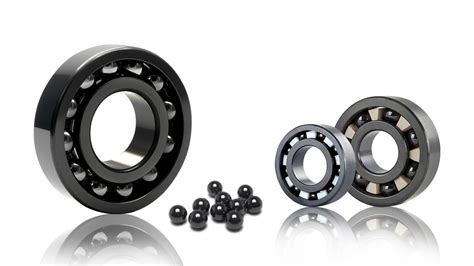Ceramic Bearings: A Comprehensive Guide
Ceramic bearings, composed of ceramic materials like silicon nitride or zirconia, offer exceptional performance characteristics that surpass those of traditional steel bearings in various applications. They boast numerous advantages, including enhanced wear resistance, corrosion resistance, and reduced friction, making them ideal for demanding environments.
Why Ceramic Bearings Matter
Ceramic bearings play a crucial role in industries where precision, durability, and reliability are paramount. They find applications in:
- Aerospace and defense
- Medical and dental equipment
- Semiconductor and electronics manufacturing
- Food and beverage processing
- High-end automotive components
These bearings enable smoother operation, reduced downtime, and increased efficiency, contributing to significant cost savings and improved product quality.
Benefits of Ceramic Bearings
-
Increased Wear Resistance: Ceramic materials exhibit superior hardness and toughness, resulting in significantly reduced wear rates compared to steel bearings.
-
Enhanced Corrosion Resistance: Ceramic bearings are highly resistant to corrosive environments, including water, acids, and chemicals, ensuring longevity in harsh conditions.
-
Reduced Friction: The smooth surface of ceramic bearings minimizes friction, leading to lower energy consumption and reduced operating temperatures.
-
Higher Speed Capability: Ceramic bearings can operate at higher speeds than steel bearings without compromising performance, enabling enhanced efficiency.
-
Lightweight: Ceramic bearings are lighter than steel bearings, reducing overall system weight and improving energy efficiency.
Comparison of Ceramic and Steel Bearings
| Feature |
Ceramic Bearings |
Steel Bearings |
| Wear Resistance |
Excellent |
Good |
| Corrosion Resistance |
Excellent |
Moderate |
| Friction |
Low |
Moderate |
| Speed Capability |
High |
Moderate |
| Weight |
Light |
Heavy |
| Cost |
Higher |
Lower |
How to Select Ceramic Bearings
Selecting the right ceramic bearings requires careful consideration of several factors:

1. Load and Speed Requirements: Determine the operating loads and speeds to ensure the bearings can withstand the specific requirements.
2. Material: Choose the appropriate ceramic material based on wear and corrosion resistance requirements.
3. Lubrication: Ceramic bearings require special lubricants compatible with their materials.
4. Housing and Sealing: Select bearings with proper housing and sealing to protect them from contamination and environmental factors.
Step-by-Step Approach:

- Define the operating conditions, including loads, speeds, and environment.
- Select the ceramic material based on wear and corrosion resistance requirements.
- Determine the bearing size and geometry.
- Choose appropriate lubrication and sealing solutions.
- Install the bearings and monitor their performance regularly.
Pros and Cons of Ceramic Bearings
Pros:
- Exceptional wear resistance
- Enhanced corrosion resistance
- Reduced friction
- Higher speed capability
- Lightweight
Cons:

- Higher cost than steel bearings
- Can be brittle under certain load conditions
- Require special lubricants and handling
Applications of Ceramic Bearings
Ceramic bearings have found widespread adoption in various industries, including:
Aerospace and Defense: Ceramic bearings are used in aircraft engines, landing gear, and missile guidance systems.
Medical and Dental Equipment: They are found in surgical instruments, dental drills, and imaging machines.
Semiconductor and Electronics Manufacturing: Ceramic bearings ensure precision and reliability in semiconductor production equipment.
Food and Beverage Processing: They prevent corrosion in food and beverage processing machinery.
High-End Automotive Components: Ceramic bearings enhance performance and reduce friction in high-end automotive applications.
Innovations in Ceramic Bearings
Advancements in ceramic bearing technology continue to drive new applications and performance enhancements.
-
Hybrid Ceramic Bearings: Incorporate ceramic rolling elements into steel bearings, offering a balance of cost and performance.
-
Silicon Nitride Ceramics: Provide exceptional wear resistance and high-temperature stability.
-
Zirconia Ceramics: Offer improved toughness and corrosion resistance.
-
Self-Lubricating Ceramic Bearings: Utilize ceramic materials that inherently reduce friction and eliminate the need for external lubrication.
Market Trends
The global ceramic bearing market is projected to witness significant growth due to increasing demand from various industries. The rising popularity of hybrid ceramic bearings and the adoption of new ceramic materials are expected to drive market expansion.
Figures:

- The global ceramic bearing market size was valued at USD 1.5 billion in 2020.
- It is projected to reach USD 2.5 billion by 2027, growing at a CAGR of 7.2%.
- The Asia-Pacific region is expected to hold the largest market share.
Table 1: Ceramic Bearing Properties
| Property | Value |
|---|---|
| Vickers Hardness (HV) | 1,500-2,000 |
| Elastic Modulus (GPa) | 280-330 |
| Density (g/cm³) | 3.2-3.9 |
| Coefficient of Thermal Expansion (10⁻⁶/°C) | 3-4 |
Table 2: Performance Comparisons of Ceramic and Steel Bearings
| Feature | Ceramic Bearings | Steel Bearings |
|---|---|---|
| Wear Resistance | 5-10 times higher | 2-3 times lower |
| Corrosion Resistance | Excellent | Moderate |
| Coefficient of Friction | 0.01-0.05 | 0.05-0.1 |
| Maximum Operating Temperature (°C) | 1,000-1,500 | 200-300 |
Table 3: Applications of Ceramic Bearings by Industry
| Industry | Applications |
|---|---|
| Aerospace | Aircraft engines, landing gear, missile guidance systems |
| Medical | Surgical instruments, dental drills, imaging machines |
| Semiconductor | Semiconductor production equipment |
| Food and Beverage | Food and beverage processing machinery |
| High-End Automotive | High-performance engines, transmissions, brakes |
Conclusion
Ceramic bearings revolutionize various industries by providing superior wear resistance, corrosion resistance, and reduced friction. They enable enhanced performance, efficiency, and durability, resulting in significant cost savings and improved product quality. As technology continues to advance, ceramic bearings will continue to play an important role in demanding applications, driving innovation and shaping the future of industries.

